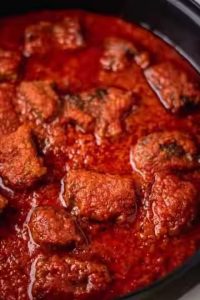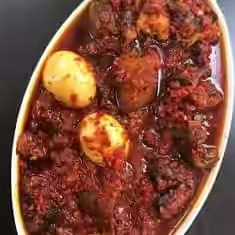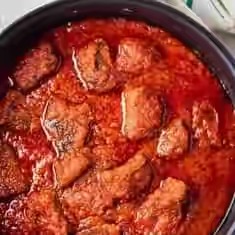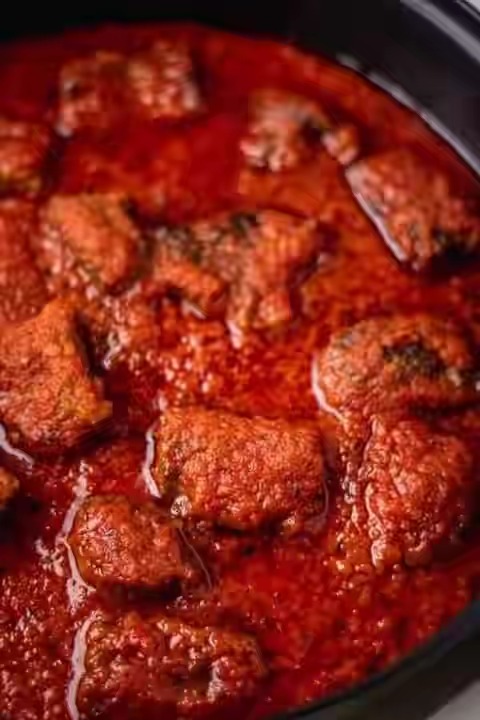This is a detailed step by step guide on how to Prepare Nigerian Tomato Stew (Ingredients & Recipes). How to make Nigerian tomato stew.
NIGERIAN TOMATO STEW
➖➖➖➖➖➖➖➖➖➖➖➖
DESCRIPTIONS
•The Nigerian tomato stew is a unique blend of tomatoes, onion, fresh peppers, fried in vegetable oil and to which meat, chicken or fish is added, with various spices.
•By tomato stew, I mean stew used to prepare the Nigerian Jollof rice, coconut rice, rice and beans, and pasta.
•This recipe is a guide on how to cook tomato stew.
➖➖➖➖➖➖➖➖➖➖➖➖
MAIN INGREDIENTS & RECIPES OF NIGERIAN TOMATO STEW
▪Chicken, meat or fish ( of choice )
▪Fresh tomatoes ( 20 plum or choice )
▪Tatashe ( 6 ground medium size )
▪Fresh peppers ( to taste )
▪Tinned tomatoes ( 210g )
▪Garlic ( 5 crushed cloves )
▪Ginger ( ground half finger )
▪Onion ( 2 chopped big sized )
▪Chicken, goat or fish flavour (of choice )
▪Curry powder (1 tbsp )
▪Thyme (1 tbsp )
▪Vegetable oil ( of choice )
▪Stock cubes ( of choice )
▪Salt ( to taste )

➖➖➖➖➖➖➖➖➖➖➖➖
OPTIONAL INGREDIENTS
▪Nutmeg (1 tsp of ground )
▪Crayfish ( 2 ground tbsp )
▪Red bell pepper (2 medium size)
▪Black pepper ( 1 ground tbsp )
▪Paprika powder (1 tsp )
▪Bay leaves ( 4 leaves )
▪Scent leaf ( a handful )
▪Curry leaf ( a handful )
▪Stew mix spices (1 tbsp )
ALTERNATIVE INGREDIENTS
▪Chicken, goat, beef or fish
▪Curry powder or curry leaves
▪Fresh or tinned tomatoes
▪Dry or fresh garlic/ginger
▪Thyme or rosemary
▪Stock cube or bouillon powder
▪Vegetable oil or palm oil
▪Seasoning flavours of choice

➖➖➖➖➖➖➖➖➖➖➖➖
PREPARATION BEFORE COOKING
•Chop some onion into big chunks and slice some onion into small pieces.
•If you are going to use it, grind the crayfish.
•Wash the vegetables and de-seed the tatashe.
➖➖➖➖➖➖➖➖➖➖➖➖
PROCEDURE FOR COOKING STEW
Cooking the Nigerian tomato stew involves 3 major steps:
1. Precooking the blended/grounded tomato mixture.
2. Parboiling the meat ( chicken, goat, lamb, beef or fish ).
3. Frying and cooking the stew.
➖➖➖➖➖➖➖➖➖➖➖➖
Precooking the blended/grounded tomato mixture. ( 1st step )
•Wash, chop and blend/grind the fresh tomatoes, fresh peppers, tatashe or bell peppers, chopped onion, garlic and ginger until smooth. If you are using blender, try blending small quantities at a time so that the mixture blends properly and that you don’t overwork your blender.
•Pour the tomatoes mixture into a pot and boil on high heat until the water is dried and set aside. Do not allow it to burn. You can also boil the tomato mixture half way and sieve it, in order to get rid of the water in it very fast.

➖➖➖➖➖➖➖➖➖➖➖➖
Parboiling and frying the meat ( chicken, goat, lamb, beef or fish ). 2nd step
•Wash and cut your chicken/meat into bite sized pieces. In a separate pot, season your chicken/meat with some sliced onions, thyme, curry powder, ground pepper, crushed garlic and ginger. Do not add any water. Let the chicken/meat cook in its juices until almost dry; then pour in some water and adjust the seasoning with salt, cover and let it cook until soft. Remove the chicken/meat from the stock and set it aside in order to drain/remove any excess liquid or particles.
•In a deep frying pan or pot, heat up some vegetable oil, put in few pieces of onion and fry until brown, but not burnt ( the onion helps to season the oil and add flavour to the chicken/meat); then remove the onion and discard. Fry the chicken/meat until golden and crisp, but not burnt.
•Drain the fried chicken/meat pieces unto a paper towel.
•Make sure you fry the chicken/meat in batches until done.
•Alternatively, steaming and grilling the chicken/meat is a healthier option.
•If you are grilling the chicken, place the chicken on a rack and cook in the oven at 330 degrees fahrenheit for 10 to 15 minutes or until it has become golden brown and set it aside.
•The steaming time of your chicken depends on the types of chicken you are cooking with. The rooster or cockerel cooks much faster than the hen, but the hen is definitely tastier than the rooster.
•Also the cooking time of your meat depends on the type of meat you choose to use, but it is important you allow your meat or chicken to boil until it is tender.
➖➖➖➖➖➖➖➖➖➖➖➖
Frying and cooking of the tomato stew. ( 3rd step )
Step 1: In a pot, heat up your vegetable oil on medium heat for 2 to 3 minutes, ( you can use the vegetable oil that was used to fry the chicken or meat ) when the oil is hot enough, add in the chopped onion and garlic and fry until the onion translucent or stir fry for about 3 to 5 minutes on low heat.
Step 2: Pour in the remaining thyme and curry powder, and stir-fry for 3 minutes. This step is very important in order to give the stew and your kitchen an excellence aroma.
Step 3: Add in the tinned tomato paste and stir fry for 5 to 7 minutes. Make sure you fry your tinned tomato before adding the the tomato mixture.
Step 4: Add in the tomatoes mixture and stir-fry. Let it fry for 10 to 14 minutes on low to medium heat or until the oil divides from the tomato mixture and starts floating on the top of the stew or until the oil start rubbing on top of the stew. Make sure you cook/fry the stew on low heat.
Step 5: Add in the nutmeg, stock cubes, salt, curry powder, thyme and other necessary spices. This step is what will give your stew a perfect taste.
Step 6: Pour in the chicken stock. Do not make the stew watery. You could pour more if you want your stew to be less thick and more watery.
Step 7: Add in the fried or grilled chicken or meat and cook for 7 to 10 minutes on low heat, so that the stew flavour will absorb into the chicken/meat.
Step 8: Taste for salt and other spices like nutmeg, curry powder, peppers or stock cubes. Taste the stew to make sure that the raw tomato taste is gone.
Step 9: When the taste and consistency are appropriate for the stew, turn off the heat.
Step 10: When the stew is cooked, you may remove some of the oil, if it seems like it is too much.
➖➖➖➖➖➖➖➖➖➖➖➖
THINGS TO NOTE
HOW TO PRESERVE THE STEW
•Nigerian tomato stew can hardly spoil, if it is properly cooked.
•If you want your stew to last up to two days without warming it, always make sure, you fry your chicken, meat or fish, before putting them in the stew.
•You can preserve your stew in the fridge or freezer.
➖➖➖➖➖➖➖➖➖➖➖➖
HOW TO SERVE THE STEW
•Your tomato stew can be eaten/ served along side with white rice, Jollof rice, bread, moi moi, beans, boiled okro, boiled or fried yam, plantain, potatoes or any swallow of your choice.
➖➖➖➖➖➖➖➖➖➖➖➖
TIPS FOR COOKING STEW
Tip 1: To check if your stew is properly cooked, taste a bit of it and if the taste of raw tomato is absent, then it is done.
Tip 2: Note, there are some species of tomatoes that, no matter the degrees of boiling them after blending, they will call you a bad cook. Fresh plum tomatoes are the best for the Nigerian tomato stew because, all the other types of tomatoes either have lots of seeds or contain lots of water. Roma tomatoes are very similar to plum tomatoes.
Tip 3: When frying your tomatoes, you need more than enough vegetable oil, so that the tomatoes will not burn till all the sour taste is gone and the water has dried from the tomatoes. You can pour out the excess oil when the tomatoes are well fried. Note, if you don’t have enough vegetable oil, your stew will have a sour taste and it will burn, even if you stand there stirring frantically and why worry, when you will pour out the excess oil when you are done.
Tip 4: Anybody worrying about his or her health, should stay away from this stew because it is fried.
Tip 5: The excess vegetable oil you will pour out from the stew is red in colour, hence it is perfect for cooking egusi soup, okro soup and ogbono soup. Once it has cool down, put it in the fridge or freezer because it will get bad if left on the kitchen counter.
Tip 6: Tinned tomatoes paste/puree.
The tinned tomatoes paste sold in Nigeria is usually very thick and concentrated. If you try to fry this tomato paste as is it, it will burn straight away. What is normally done is to add some cold water to it, to bring it to the softer consistency but, if you are using tomato puree, don’t add in water to mix it. Note that, adding little water to mix your tinned tomato is optional.
Tip 7: The outcome and taste of any stew also depends on the quantities of tomatoes, peppers and onions used and how these vegetables are treated.
Tip 8: The general practice is to blend/grind the tomatoes, peppers, and onions, boil and use for frying, while some will fry the blended/ground tomatoes mixture straight without boiling it. The challenge with the last method is that, frying time is more longer, as the oil prevents the water from evaporating fast.
Tip 9: It is best to marinate your meat/chicken before steaming them with the necessary Ingredients for up to 30 minutes, because it will allow the ingredients to enter the meat properly and add more taste to it.
Tip 10: It will take up to 40 to 45 minutes to cook your stew properly.
Tip 11: You can use any meat, chicken, turkey or fish of your choice to cook your tomato stew.
Tip 12: When frying your chicken or meat, make sure you fry them until they turn golden brown.
Tip 13: Make sure you cook/fry your stew in medium to low heat.
Tip 14: Note that, Tinned tomato is optional to this stew. You can cook the stew only with fresh tomatoes or you can also cook the stew only with tinned tomato.
Tip 15: Tatashe is also used to improve the redness of the tomato stew.
The end
This article is on how to prepare NIGERIAN tomato stew is wholly the intellectual property of Mary Joseph and was first shared on the Facebook page of HOW TO COOK AFRICAN FOODS (HTCAF)….The article was culled by www.nimedhealth.com.ng for the education and enlightenment of our readers.
























